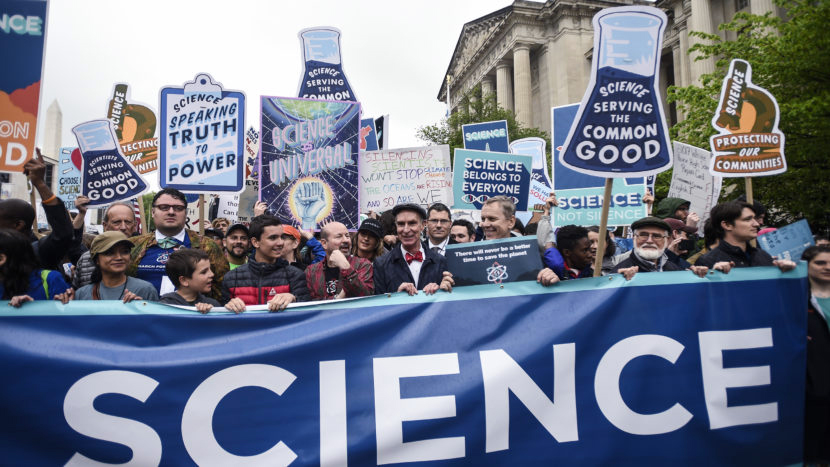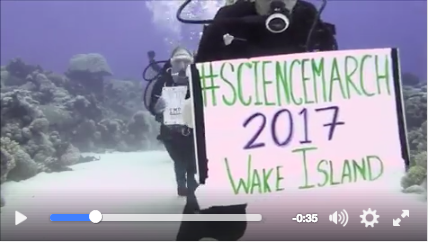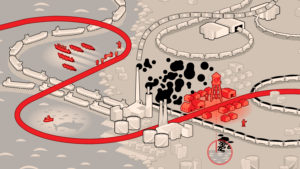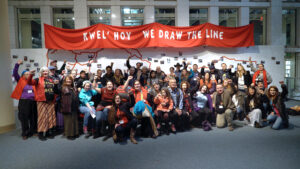Friends,
This weekend was exhilarating. The March for Science took place in 600+ cities and all 7 continents (yes, even Antarctica). Crowd estimates in DC surpassed 100,000, in spite of rain. There was a march of penguins, a march on the bottom of the ocean, and marches on both poles of the planet!

Our team at The Natural History Museum played a central role in developing the mission statement and overall messaging strategy for the march–moving beyond science boosterism to uplift science that serves the common good, speaks truth to power, and protects the people and places we love. We designed the front of the march (above), worked with our scientist collaborators to place op-eds, and facilitated segments on PBS News Hour, ZDF German TV and Democracy Now (links below). We’re proud to have helped recruit several science museums and institutions to step out of their comfort zones to endorse the march and play a more active role in championing a safe and equitable future for all. Finally, we collaborated with the Center for Native Peoples and the Environment to organize a letter affirming the role of Indigenous Science and traditional ways of knowing, signed by 1,700 Indigenous scientists, tribal leaders, and allies.
All told, this is unprecedented: never before have scientists and science institutions stepped into the public sphere in such a big way. There have historically been fierce debates around the question of neutrality in science. We’ve taken a quantum leap forward in normalizing science activism and engaging the single most trusted constituency in America. Scientists mobilized en masse–for the first time ever–to champion sacred notions of truth, defend climate science, EPA science, and health research, and advocate alongside traditionally marginalized communities hit hardest by the war on science.
Below is a round-up of highlights, including our interview with Democracy Now! at the top of their 5-hour live broadcast. We discussed the march, science activism, and The Natural History Museum’s recent successes and upcoming plans.
MEDIA HIGHLIGHTS
- Nationally syndicated TV and radio show Democracy Now! opened a 5-hour live broadcast with an interview with The Natural History Museum’s Founding Director Beka Economopoulos.It’s at the beginning, check it out!
The Natural History Museum’s own Lucky Tran, a scientist and science communicator, penned an op-ed that’s well worth reading, he nails it:
“The real question is who does science serve? When politicians are left alone to attack science with impunity, the answer is that science serves only the most elite, and is obstructed from helping all of us. As a result, real people get hurt, particularly our most vulnerable and marginalized communities. Look at lead poisoning in Flint. Or Hurricane Katrina and Superstorm Sandy. Or the Dakota Access pipeline. Or the rising seas of Tuvalu. Or the Ebola outbreak in west Africa. Or the measles outbreak in Europe.
I’m marching because science needs to take a stand and fight for justice with the communities who are harmed by bad science policy.”
“We need another scientific revolution. The first scientific revolution transformed our understanding of the natural world and changed civilization as we know it, making us healthier, happier and more productive. Today, we have huge scientific challenges ahead such as climate change, genetic engineering and automation. And yet we are stuck with the handbrake on and unable to act effectively as a society, because a few privileged people are blocking progress at the expense of the rest of us.
That’s why we urgently need to transform the relationship between science, politics and society: our collective futures depend on it. That’s why I’m marching, because we need to change history. It’s time to join the revolution.”
- A Peer Review of the March for Science, MOBProd (PBS News Hour and PBS NOVA partner)
Scientist Geoffrey Supran, one of The Natural History Museum’s collaborators, published this analysis of the march:
“The March For Science mobilized the immobilizable. For many, this was a gateway into political engagement and activism. The March For Science forced many scientists — not to mention the public, press, and politicians — to grapple with the role of science in society and the relationship between science and politics. As scientists with little or no past experience in political engagement wrestled for the first time with the fear of politicizing science, the march went from officially apolitical to political-but-non-partisan. With time, the march’s communications improved, and on the day, its global message was unambiguous: science serves society.
Unlike the scientific method, the science movement does not — and should never — exist in a bubble. We should embrace opportunities to connect science to real-world issues; both in what we say and who we collaborate with. In my own field of energy and climate change, for example, we should talk about how last year alone, the solar industry hired more people than the coal industry employs in its entirety. We should talk about how fossil fuel pollution and climate change disproportionately harm and kill minorities and indigenous groups. In short, we should stand in solidarity with those who our science strives to protect. Not only is this the right thing to do, it is politically effective; by building narratives of shared values, we can broaden our coalition and win the political story wars.”
- Historians Say the March for Science is “Unprecedented”, Washington Post
“The march is pretty unprecedented in terms of the scale and breadth of the scientific community that’s involved, and it does recall Physicians for Social Responsibility and various scientific groups against nuclear war in the Reagan era, that’s I think the most recent precedent,” said Robert Proctor, a professor of the history of science at Stanford University. “But this is even broader in the sense that there’s a broader perception of a massive attack on sacred notions of truth that are sacred to the scientific community.”
- Scientists, Feeling Under Siege, March Against Trump Policies, The New York Times
“This has been a living laboratory as scientists and science institutions are willing to take a step outside their comfort zone, outside of the labs and into the public spheres,” said Beka Economopoulos, a founder of the pop-up Natural History Museum and an organizer of the march. Mona Hanna-Attisha, a pediatrician who helped expose lead poisoning in Flint, Mich., and who spoke in Washington, called the protest the beginning of a movement to ensure that governments do not dismiss or deny science, putting communities at risk.
- Scientists Dive Into the Political Fray, PBS News Hour
An excellent PBS News Hour feature on national TV this week showcased our “Rally to Stand Up For Science“, organized and emceed by The Natural History Museum with ClimateTruth.org this past February.
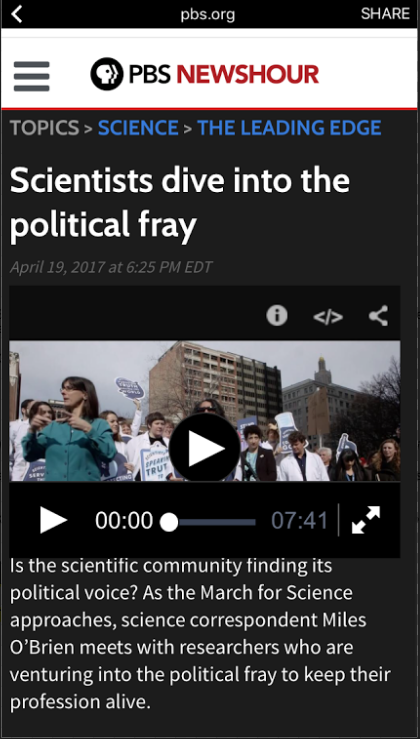
INDIGENOUS SCIENCE LETTER
The Natural History Museum teamed up with the Center for Native Peoples and the Environment and Indigenous scientists to organize a March for Science endorsement letter affirming the role of Indigenous Science and traditional ways of knowing. It was signed by 1,700 Indigenous scientists, tribal leaders and allies. Some highlights:
Let Our Indigenous Voices be Heard: Indigenous Scientists Join March for Science, Canada Broadcasting Corporation (CBC.ca)
How the March for Science Finally Found Its Voice, The Atlantic
These Native American Scholars Marched for Indigenous Science, Buzzfeed News
“Indigenous communities in the US, from Louisiana to Alaska to Montana, are already feeling the effects of climate change and preparing to survive despite it, sometimes tapping into indigenous knowledge system.
“Let us remember that long before Western science came to these shores there were indigenous scientists here — native astronomers, geneticists, botanists, engineers — and we are still here,” Kimmerer said, during a speech at the March For Science event in DC.
“There are a lot of people who say when climate change comes to us we’ll just go,” Kimmerer said. “[But] many indigenous peoples are extremely vulnerable to climate change and are in homelands that they cannot leave.””
HIGHLIGHTS FROM THE GLOBAL MARCHES
MARCH OF THE PENGUINS, UNDERWATER MARCHES, and BOTH POLES OF THE PLANET
Arguably the most delightful of all marches, the Monterey Bay Aquarium organized a penguin march for science. Really.
There’s also these marine biologists who staged an underwater march off the coast of Wake Island in the Pacific Ocean, where the coral reefs have been bleached by climate change.

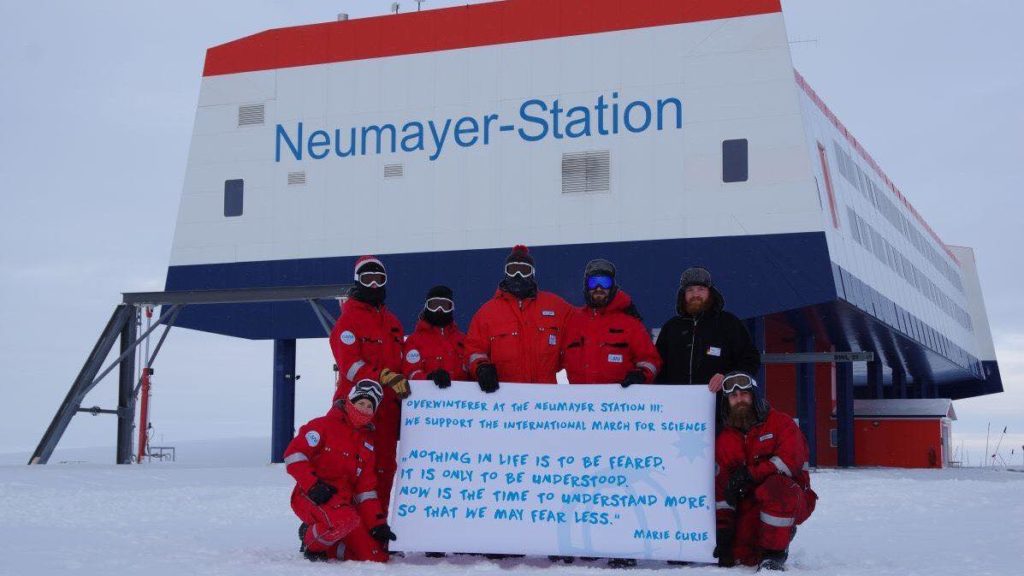
There were even marches by scientists on assignment in the Arctic and the Antarctic.

